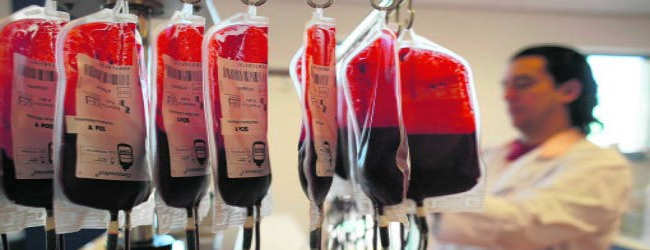Sideroblastic anemia: what is it, causes, symptoms, treatment, prognosis
Content
- What is sideroblastic anemia?
- Signs and symptoms
- Causes
- Affected populations
- Related disorders
- Diagnostics
- Standard treatments
- Forecast
What is sideroblastic anemia?
Sideroblastic anemia are a group of blood disorders in which the body has enough iron, but the body cannot use it to produce hemoglobin, which carries oxygen in the blood. As a result, iron accumulates in the mitochondria of erythrocytes, giving the nucleus a circular appearance.
There are three types of sideroblastic anemia: hereditary, acquired, and idiopathic (of unknown origin).
Signs and symptoms of this anemia can range from mild to severe and include fatigue, shortness of breath, and weakness. May also happen enlargement of the spleen or liver. In severe cases, elevated blood iron levels can lead to heart disease, liver damage, and renal failure.
Signs and symptoms

Sideroblastic anemias characterized by tiredness, shortness of breath, and feeling weak. With exercise, people with this disorder may experience chest pains similar to angina.
The more common forms of anemia are caused by a deficiency of iron in the blood. People with sideroblastic anemias have abnormally high levels of iron and iron-containing substances in the blood serum. In some cases, the mucous membranes, skin of the hands and face with sideroblastic anemia may look pale, often lemon yellow. Rarely, a brownish-red discoloration caused by bleeding under the skin may appear.
Enlarged spleen (splenomegaly) or liver (hepatomegaly) are other symptoms of this disorder. Acute leukemia develops in less than 10% of cases as a complication of progressive sideroblastic anemias.
Causes

Hereditary sideroblastic anemia is the result of a defect in an X-linked recessive gene. The gene known as ALAS2, produces an enzyme that is necessary for the production of "heme", The oxygen-containing part of the hemoglobin molecule. The defective gene is located on the X chromosome (Xp11.21).
Read also:Decreased hemoglobin in women and men, what does this mean and what should be done?
X-linked sideroblastic anemia usually appears at some point during the first three decades of life.

Chromosomes, which are present in the nucleus of human cells, carry the genetic information of each person. The cells of the human body usually have 46 chromosomes. Pairs of human chromosomes are numbered 1 through 22, and the sex chromosomes are labeled X and Y. Men have one X and one Y chromosome, while women have two X chromosomes.
Each chromosome has a short arm labeled "p", And a long shoulder marked"q». Chromosomes are further subdivided into multiple bands, which are numbered. For example, "chromosome Xp11.21" refers to the 11.21 band on the short arm of the X chromosome. The numbered stripes indicate the location of the thousands of genes present on each chromosome.
X-linked recessive genetic disorders are conditions caused by an abnormal gene on the X chromosome. Females have two X chromosomes, but one of the X chromosomes is turned off, and all genes on that chromosome are inactivated.

Women who have a disease gene on one of their X chromosomes are carriers of the disorder. Carrier women usually do not show symptoms of the disorder because it is usually an X chromosome with an abnormal gene that is turned off.
A man has one X chromosome, and if he inherits the X chromosome containing the disease gene, he will develop the disease. Men with X-linked disorders pass the disease gene to all of their daughters who will be carriers. A man cannot pass the X-linked gene to his sons because men always pass on their Y chromosome instead of their X chromosome to male offspring.
Acquired sideroblastic anemia is the result of prolonged exposure to certain toxic substances and drugs or an unpleasant effect other disorders, such as immune disorders, granulomatous diseases, tumors, or metabolic disorders.
As the name suggests, the reason idiopathic sideroblastic anemia unknown.
Affected populations
Hereditary sideroblastic anemia affects both men and women, but is more common in men. The onset of this form of the disorder usually occurs before the age of 30, although there have been cases of the disorder being diagnosed in patients over the age of 70.
Read also:Anemia (anemia) in adult women and men: causes, what are the symptoms and what is the treatment
Acquired sideroblastic anemia is more common in older patients of either sex, usually 65 years of age or older. However, there have been cases of patients being diagnosed with the disease in their mid-50s.
Related disorders
In addition to the forms of sideroblastic anemia described above, there are several additional types or subtypes that are extremely rare.
Thalassemia minor and big (large) Are two hereditary anemias. Thalassemia minor is the milder form of the two. Large thalassemia (Cooley's anemia) belongs to the group of chronic familial hemolytic anemias. It is characterized by a marked increase in F-hemoglobin and a decrease in the synthesis of beta-polypeptide chains in the hemoglobin molecule. Symptoms include a decrease in the number of red blood cells, generalized weakness, a vague feeling of malaise, an upset stomach and palpitations.
Idiopathic hemochromatosis Is a hereditary disorder of iron metabolism, characterized by excess iron deposits in tissues, especially in the liver, pancreas and the heart, as well as the pigmentation of the skin in a bronze color. Liver cirrhosis may also occur, diabetes and related changes in bones and joints.
For more information on the aforementioned disorders, go to the page "Thalassemia" and "Hemochromatosis».
Diagnostics
The suspicion of sideroblastic anemia will result in a physician ordering blood tests, including erythrocyte staining to determine if characteristic ring-shaped sideroblasts are present in mitochondria. Biochemical tests can be performed to determine the level of an enzyme required for hemoglobin, delta-aminolevulin synthetase.
Standard treatments
Treatment depends on the cause of the sideroblastic anemia. If the disorder is acquired, the responsible agent must be identified and treated.

Vitamin B6 therapy (Pyridoxine) can be useful in some cases.
To remove excess iron from the body of a person with sideroblastic anemia, it is injected under the skin (subcutaneously) or into the muscle (intramuscularly) the drug Deferoxamine - this often gives a positive response. Deferoxamine binds excess iron and promotes its excretion from the body.
Read also:Thrombocytopenia
In extreme cases, blood transfusions are used.
Forecast
The prognosis for the development of sideroblastic anemia varies depending on the underlying cause. In acquired cases, such as those associated with alcohol and drug use, there may be no long-term symptoms.
Patients requiring blood transfusions, patients with diseases not responding to pyridoxine and other methods treatment, as well as patients with myelodysplastic syndrome, which develops into acute leukemia, have a lower forecast. The main causes of death in this anemia are secondary hemochromatosis with blood transfusion and leukemia.
Thrombocytosis is a relatively good prognostic sign. Patients who do not need a blood transfusion are more likely to survive for a long time, while while those who become dependent on blood transfusions risk further death from complications of secondary hemochromatosis.



